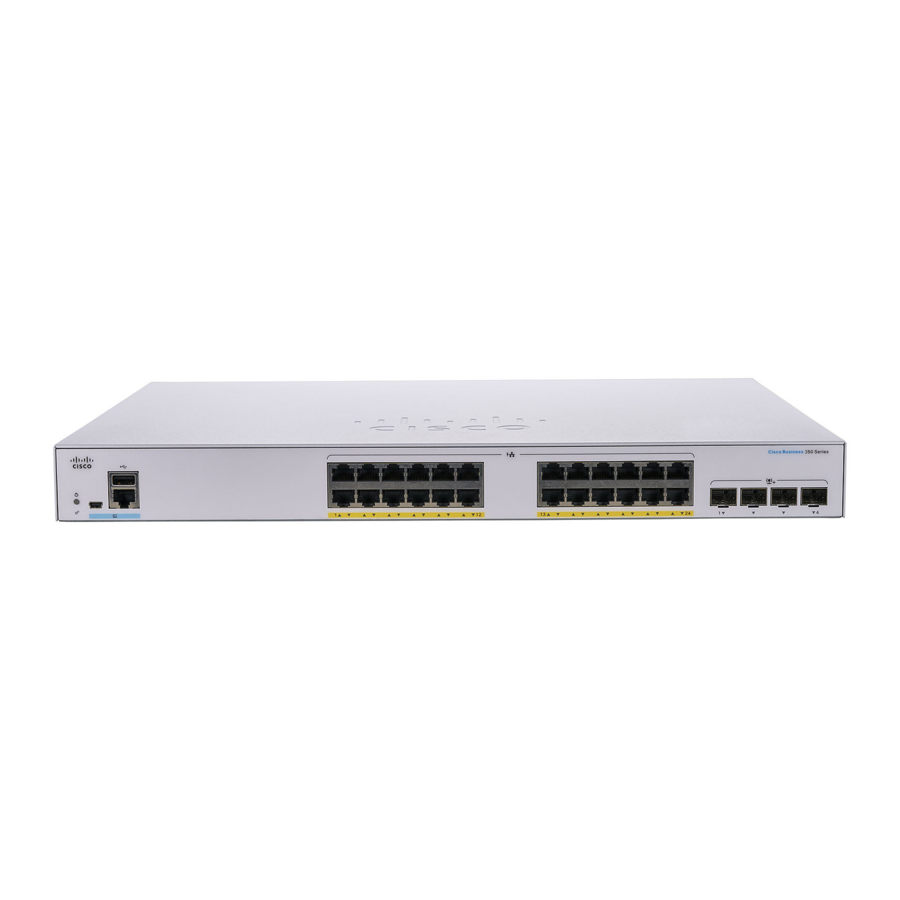Advertisement
Get To Know Your Switch
This chapter contains the following sections:
•
•
•
•
•
•
•
•
Introduction
Thank you for purchasing the Cisco CBS Series Switch. The Cisco CBS Series Switches combine powerful
network performance and reliability with a complete suite of network features that you need for a solid business
network. These expandable Gigabit Ethernet switches, with Gigabit or 10-Gigabit uplinks, provide multiple
management options, rich security capabilities, and Layer-3 static routing features far beyond those of an
unmanaged or consumer-grade switch, at a lower cost than fully managed switches.
Before You Begin
Before you begin installing your device, ensure that the following items are available:
• RJ-45 Ethernet cables for connecting network devices. A category 6a and higher cable is required for
• Tools for installing the hardware.
Introduction, on page 1
Rack Mounting Switch, on page 2
Wall Mounting a Switch, on page 3
Power over Ethernet Considerations, on page 5
Front Panel, on page 7
Configuring Switches, on page 9
Restoring Factory Default Settings, on page 12
Navigation, on page 12
10G ports; a category 5e and higher cable is required for all other ports.
• The rack-mount kit packed with the switch contains four rubber feet for desktop placement, and
two brackets and twelve screws for rack mounting.
• If the supplied screws are lost, use replacement screws in the following size:
• Diameter of the screw head: 6.9 mm
• Length of the face of the screw head to the base of screw: 5.9 mm
• Shaft diameter: 3.94 mm
Get To Know Your Switch
1
Advertisement

Summary of Contents for Cisco CBS Series
-
Page 1: Table Of Contents
Navigation, on page 12 Introduction Thank you for purchasing the Cisco CBS Series Switch. The Cisco CBS Series Switches combine powerful network performance and reliability with a complete suite of network features that you need for a solid business network. These expandable Gigabit Ethernet switches, with Gigabit or 10-Gigabit uplinks, provide multiple management options, rich security capabilities, and Layer-3 static routing features far beyond those of an unmanaged or consumer-grade switch, at a lower cost than fully managed switches. -
Page 2: Rack Mounting Switch
Get To Know Your Switch Rack Mounting Switch Warning To prevent airflow restriction, allow clearance around the ventilation openings to be at least 3 inches (7.6 cm). • A computer to manage the device either via the console port or via the web-based interface. for web-based interface the computer needs to support one of the following browsers: •... -
Page 3: Wall Mounting A Switch
Get To Know Your Switch Wall Mounting a Switch Due to design differences, some of the mounting brackets will attach such that the switch will protrude about an inch from the mounting surface. Supplied rack mounting for switch models with front mounting position. The mounting ears sit flush to the front panel. - Page 4 Get To Know Your Switch Wall Mount an 8 Port Switch Step 1 Attach a 19-inch bracket to one side of the switch. Step 2 Repeat the previous step to attach the other bracket to the opposite side of the switch. Step 3 After the brackets are securely attached, mount the switch with the front panel facing down.
-
Page 5: Power Over Ethernet Considerations
Get To Know Your Switch Power over Ethernet Considerations Step 7 Remove the screw template from the wall. Step 8 Place the switch onto the mounting screws, and slide it down until it locks in place. Wall-mounting an 8-port switch Figure 4 Wall-mounting an 8-port switch Power over Ethernet Considerations Some switches support PoE while others do not. - Page 6 Get To Know Your Switch Power over Ethernet Considerations Warning The switch is to be connected only to PoE networks without routing to the outside plant. Table 1: Switches with Power Over Ethernet SKU Name Description PoE PD Chipset Type PoE PSE Support CBS250-8PP-D 8-Port Gigabit PoE Smart...
-
Page 7: Front Panel
The ports, LEDs, and Reset button are located on the front panel of the switch, as well as the following components: Cisco Business 250 Series Model Note Models may differ within the CBS 250 series and this is just a representation of a model within the series. - Page 8 Get To Know Your Switch Front Panel • The SFP+ ports (if present) are compatible with the following Cisco SFP 1G optical modules MGBSX1, MGBLX1, MGBLH1, MGBT1, as well as other brands. • The SFP+ ports are compatible with the following Cisco SFP 1G optical modules MGBSX1, MGBLX1, MGBLH1, MGBT1, as well as other brands.
-
Page 9: Configuring Switches
Uplink ports on CBS350-8MGP-2X also support multi-Gigabit speed. In this case, port speed can reach 10Gbps. Most of the cabling deployed worldwide is Cat5e, and previously limited to 1 Gbps at 100 meters. Cisco multi-Gigabit Ethernet enables speeds up to 2.5 or 5 Gbps on the same infrastructure without replacing a cable. - Page 10 When the login page appears, choose the language that you prefer to use in the web-based interface and enter the username and password. The default username is cisco. The default password is cisco. Usernames and passwords are both case sensitive. Step 7 Click Log In.
- Page 11 Console access also provides additional interfaces for debug access which are not available via the web interface. These debug access interfaces are intended to be used by a Cisco Support Team personnel, in cases where it is required to debug device’s behavior.
-
Page 12: Restoring Factory Default Settings
Restoring Factory Default Settings • Run time debug modes- allows Cisco support team to view device settings and apply protocol and layer 1 debug commands and settings. The run time debug mode is accessible over telnet and SSH terminals in addition to the console.














Need help?
Do you have a question about the CBS Series and is the answer not in the manual?
Questions and answers